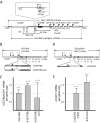Autonomous actions of the human growth hormone long-range enhancer
- PMID: 25662214
- PMCID: PMC4344525
- DOI: 10.1093/nar/gkv093
Autonomous actions of the human growth hormone long-range enhancer
Abstract
The human growth hormone (hGH) gene is controlled by a long-range enhancer, HSI, located 14.5 kb 5' to the hGH promoter. HSI establishes a domain of noncoding transcription that is 'looped' to the hGH promoter as an essential step in initiating hGH gene expression. Thus, defining how HSI generates its domain of noncoding transcription is central to understanding its long-range function. Here, we demonstrate that activation of noncoding transcription reflects an HSI-autonomous activity fully independent of interactions with linked gene promoters and occurring in spatial and temporal synchrony with initiation of GH expression in the embryonic pituitary. HSI establishes its noncoding transcription start sites (TSS) over a defined distance from its core determinants and in a manner independent of local primary sequences. The interval between HSI and it TSS co-maps with a domain of disordered and/or highly mobile nucleosomes specific to the pituitary locus. Thus, a localized chromatin reconfiguration by HSI and consequent establishment of an adjacent domain of noncoding transcription constitute initiating events in long-range enhancer function within the hGH locus.
© The Author(s) 2015. Published by Oxford University Press on behalf of Nucleic Acids Research.
Figures





Similar articles
-
An RNA-independent linkage of noncoding transcription to long-range enhancer function.Mol Cell Biol. 2012 May;32(10):2020-9. doi: 10.1128/MCB.06650-11. Epub 2012 Mar 19. Mol Cell Biol. 2012. PMID: 22431516 Free PMC article.
-
The juxtaposition of a promoter with a locus control region transcriptional domain activates gene expression.EMBO Rep. 2008 Sep;9(9):891-8. doi: 10.1038/embor.2008.126. Epub 2008 Jul 18. EMBO Rep. 2008. PMID: 18636089 Free PMC article.
-
DNase I hypersensitive site II of the human growth hormone locus control region mediates an essential and distinct long-range enhancer function.J Biol Chem. 2012 Jul 20;287(30):25454-65. doi: 10.1074/jbc.M112.365825. Epub 2012 Jun 5. J Biol Chem. 2012. PMID: 22669946 Free PMC article.
-
Lingering Questions about Enhancer RNA and Enhancer Transcription-Coupled Genomic Instability.Trends Genet. 2017 Feb;33(2):143-154. doi: 10.1016/j.tig.2016.12.002. Epub 2017 Jan 10. Trends Genet. 2017. PMID: 28087167 Free PMC article. Review.
-
The roles of placental growth hormone and placental lactogen in the regulation of human fetal growth and development.J Pediatr Endocrinol Metab. 2000 Apr;13(4):343-56. doi: 10.1515/jpem.2000.13.4.343. J Pediatr Endocrinol Metab. 2000. PMID: 10776988 Review.
Cited by
-
Functional characterization of a human POU1F1 mutation associated with isolated growth hormone deficiency: a novel etiology for IGHD.Hum Mol Genet. 2016 Feb 1;25(3):472-83. doi: 10.1093/hmg/ddv486. Epub 2015 Nov 26. Hum Mol Genet. 2016. PMID: 26612202 Free PMC article.
References
-
- Dekker J., Rippe K., Dekker M., Kleckner N. Capturing chromosome conformation. Science. 2002;295:1306–1311. - PubMed
-
- Sexton T., Bantignies T., Cavalli G. Genomic interactions: chromatin loops and gene meeting points in transcriptional regulation. Semin. Cell Dev. Biol. 2009;20:849–855. - PubMed
-
- Noordermeer D., Branco M.R., Splinter E., Klous P., van Ijcken W., Swagemakers S., Koutsourakis M., van der Spek P., Pombo A., de Laat W. Transcription and chromatin organization of a housekeeping gene cluster containing an integrated beta-globin locus control region. PLoS Genet. 2008;4:e1000016. - PMC - PubMed
Publication types
MeSH terms
Substances
Grants and funding
LinkOut - more resources
Full Text Sources
Other Literature Sources

